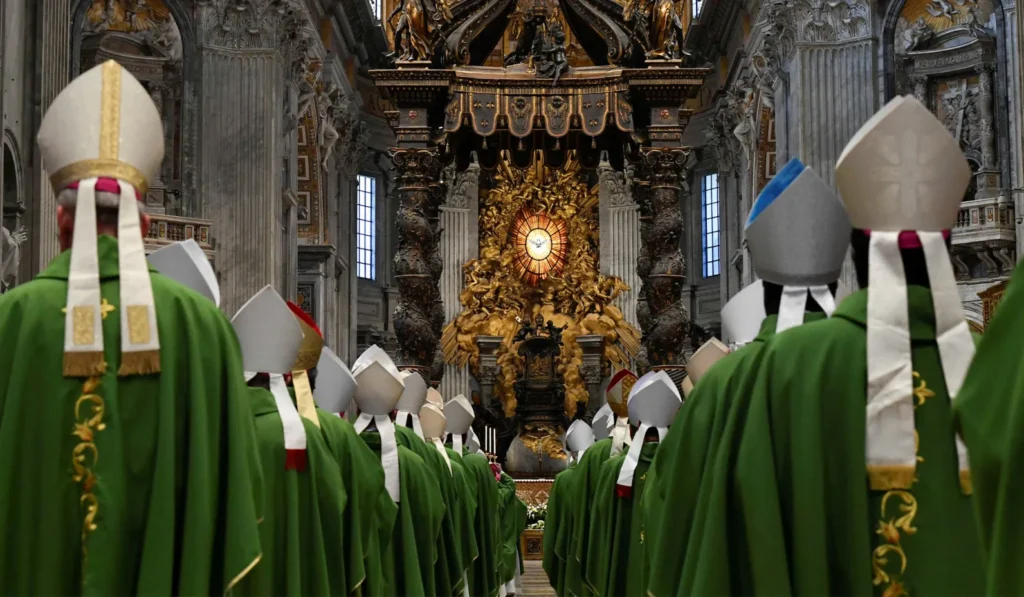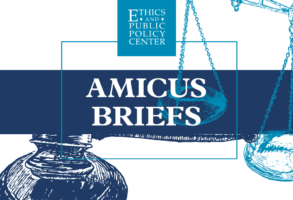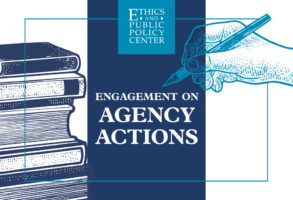
Published November 9, 2023
After three years of preparation, the first session of the 16th Ordinary General Assembly of the Synod of Bishops met in the Vatican in October. Around 400 Catholic bishops, priests, laymen and laywomen, and vowed religious from around the world joined Pope Francis for three weeks of prayer, dialogue, and listening. Most know this gathering simply as the “Synod on Synodality.”
Now, if you are somewhat unclear about what the words “synod,” “synodal,” and “synodality” mean, you are not alone. As the synod itself observed in a concluding report published at the end of October, “‘synodality’ is a term unfamiliar to many members of the People of God, causing some people confusion and concern.” Indeed.
The word “synod” comes from the Greek, meaning “walking together.” The word has been used by Christians, particularly in the Eastern churches, since ancient times to describe certain meetings of bishops. But the way the word, and especially its derivations “synodal” and “synodality,” is used today in the Catholic Church is a novelty.
There exists, the report also concedes, “a need to clarify the meaning of synodality at different levels, in pastoral, theological, and canonical terms,” in order to “avert the risk that the concept sounds too vague or generic or appears as a fad or fashion.” This is true. But what synodality adds to, subtracts from, or clarifies in the Nicene formula by which Christians (not just Catholics) have understood the church for 17 centuries (the church is “one, holy, catholic, and apostolic”) seems to be a question few in Rome have thought to ask.
The meaning of “synodality,” while yet undefined, has grown to be almost all-encompassing. Consider the partial definition of “synodality” given by the synod itself: “In its broadest sense, synodality can be understood as Christians walking in communion with Christ toward the Kingdom along with the whole of humanity.” It seems there is no part of the church — indeed no part of history itself, as Christians understand it — that is beyond the synodal. It’s as though the Catholic Church had recast the Hegelian maxim in ecclesial terms: “What is synodal is real; what is real is synodal.”
If that sounds a bit overwrought, consider what one participant, an Italian priest chosen by the synod to address the press, had to say: “When we reach the consensus that the church is constitutively synodal, we will have to rethink the whole church, all the institutions, the whole life of the church in a synodal sense.” This sort of exaggerated language — at once vague and grandiose — dominates discussions about the synod. It also explains, in part, how the synod has become such a magnet for long-standing ecclesial controversies.
Rome has gone to great lengths to convince Catholics that, in the Synod on Synodality, Something Big is happening. But Rome also professes to have little sense of just what the substance of that Something Big might be. And so everyone with an agenda to promote, an ecclesial axe to grind, or an ambition to satisfy has rushed in to fill the void.
Pope Franics has done relatively little to restrain this impulse. True, he has repeatedly insisted that the synod is not a parliament, is not about rewriting doctrine, and follows no preconceived agenda. (He regularly insists that “the protagonist of the synod must be the Holy Spirit” or else it will fail.) But he has also invited participants to the synod who see synodality precisely in such parliamentary terms, appointing members and even leaders of the synod who openly call for the revision of Catholic doctrine and, should it come to that, the abandonment of apostolic tradition.
The synod plays a purely consultative role; its findings or recommendations are not binding. But it exists to influence the pope, or at least to inform his thinking on important or contested matters. The synod doesn’t teach, but it can nudge the teacher. The result has been a synod process into which tremendous hopes and fears have been poured. A predictable slate of hot-button issues appeared poised to take center stage.
Anyone familiar with progressive Christianity in the more secularized and decadent parts of the West can guess what these issues might be: They all have to do with sex or power.
Progressives wondered when the church might finally move toward more-democratic forms of governance, curtailing the authority of bishops in favor of lay oversight. When will the church finally allow women to be ordained to the priesthood, or at least the diaconate? Can the synod recommend that the church finally bring its understanding of human sexuality into the 21st century and stop alienating LGBTQ+ Catholics, or at least allow for the blessing of same-sex relationships?
Critics, meanwhile, wondered why the synod was eager to listen so closely to those parts of the church that are sclerotic and dying (in Germany, for example) rather than to areas where it is not just surviving but thriving (much of Africa and even parts of the United States). And why, critics wondered, was the church spending several years revisiting, yet again, debates that ought to have been settled during the pontificates of John Paul II and Benedict XVI? How does it help the church move forward to return to the debates of the 1970s? How was this supposed to advance Pope Francis’s oft-stated hope for a church that is less self-referential and more focused on evangelization?
With all these tensions and frustrations and hopes and fears in the air, the synod convened. Over three weeks, participants listened to and spoke with one another. Many praised the experience as a reminder that, though there are disagreements in the church, the bonds of a common baptism are stronger. Whether such an experience, however edifying it was for a few hundred participants, justified the cost in time, resources, and energy — to say nothing of the controversy, confusion, and disruption it caused outside the synod hall — is a question many will be asking. Nothing was decided; many hopes and fears were deferred.
During the earliest years of the church, the Roman Empire proved a powerful conduit for spreading the new faith even as it presented acute dangers in the form of persecution and martyrdom. The conversion of Constantine brought an end (mostly) to persecution within the empire, but Christianity’s triumph brought new challenges and temptations: power, wealth, luxury. Ecumenical councils were called to settle theological disputes and codify Christian doctrine.
Later, as the Western empire collapsed, a new form of monasticism arose and laid the foundations for a new kind of Christian civilization. During the Middle Ages in Europe, virtually the whole continent was Catholic and the faith was integrated into every aspect of life. And the church adapted again. The great mendicant orders, the Franciscans and the Dominicans, brought a new vitality to monastic life with their zeal and poverty. Great theologians — Saint Thomas Aquinas foremost among them — made use of ancient philosophy to shed new light and understanding on perennial truths about God and man.
The Reformation turned Western Christianity upside down, and in the Counter-Reformation the Catholic Church took on yet a new countenance and posture. As wars between Catholic and Protestant sovereigns raged, new mission territories opened, especially in the Americas.
The church weathered triumph and disaster, heresies and controversies, good popes and wicked ones. Plagues raged and subsided; invaders came and went. The church produced great saints and terrible sinners. Through it all the church never ceased to adapt her mode of living and working to her new circumstances. And through it all, she proclaimed the same gospel and preserved the teachings she had received, through the apostles, from Christ himself.
When he opened the Second Vatican Council in 1962, Pope John XXIII understood that the Catholic Church was again in need of a change. As always, the challenge for the church would be to adapt to needs of the day while remaining a faithful custodian of the eternal truths entrusted to her. The documents of the Second Vatican Council sketched out what such an adaptation might look like. The council insisted that all of the baptized, not just the clergy, are, by virtue of baptism, responsible for the mission of the church. Every Christian is commissioned to spread the Good News according to his station and vocation in life.
Here we stumble upon a way of understanding “synodality” that describes something present in the church since the beginning: bishops, priests, laity all working in concert, helping one another to live lives of charity, to grow in virtue and holiness, and proclaiming the gospel. This kind of “synodality” is already present in every vibrant, thriving part of the church today, even if no one thinks to call it by that name. One can imagine that such a synodality (by whatever name it is called) might become the modus vivendi of the Catholic Church in this century and beyond.
In secularized societies, the church may need to focus less on maintaining large legacy institutions and more on the personal relationships and small communities that can support the faithful while being leaven to the world. Twenty-first-century Catholicism, in other words, may need to learn to look and act more like the poor church of the second or third century than the church of the 19th or early 20th century.
Over the coming ten months, the Catholic Church will prepare for the second session of the Synod on Synodality. Next October’s meeting will no doubt be shaped by many of the same hopes and fears that shaped this year’s meeting. Many of the same questions will be asked. Many of the same objections and concerns will be raised. Expectations will inflate and deflate.
Maybe the next ten months will provide a clearer sense of what synodality means. Maybe there will be a clearer sense of what forms synodality might realistically take in the lives of everyday Catholics, in parishes, schools, families, and dioceses around the world. It is possible that an understanding of synodality will eventually emerge and even prevail in the church, an understanding in which both fidelity to scripture and tradition and missionary zeal — a commitment to both truth and love — are universally cherished and fostered. If that happens, then synodality really will have become, as Pope Francis hopes, the way of the church in the modern world. For now, such a hope is still very far off. And the synod and the Catholic Church have a long road to travel.
But most Catholics in the U.S. can’t be bothered to go to Mass once a week under pain of grave sin; are they really going to sit through hours of regular synod listening sessions in the parish hall? Maybe the Synod on Synodality will prove that, whatever merit there is in the emphasis on synodality — a centralized effort managed from Rome, with minuscule local buy-in or participation — it is neither the best use of the church’s time and energy nor an effective way to strengthen communion, confirm the faithful, or spread missionary zeal.
Stephen P. White is a fellow in the Catholic Studies Program at the Ethics and Public Policy Center. Mr. White’s work focuses on the application of Catholic social teaching to a broad spectrum of contemporary political and cultural issues. He is the author of Red, White, Blue, and Catholic (Liguori Publications, 2016).










